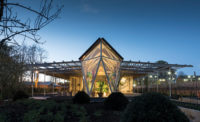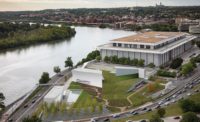“Light has always been my favorite building material,” says architect Steven Holl. At his new Maggie’s Cancer Caring Center at Barts Hospital in London, light does seem to assume near-tangible properties. Commissioned by a charity that has created more than 20 such freestanding centers designed around the UK by top architects, the facility offers cancer patients and their families practical and emotional support. This center uses carefully moderated illumination to draw in those who feel anxious, to lift their mood and foster intimate conversations. “This small building is important because it can change the way people feel at a difficult time,” says Holl. “Light is essential in doing that.”
Additional Content:
Jump to credits & specifications
The compact three-story structure sits at the heart of the hospital campus, tucked into the north corner of a grand quadrangle, adjoining an 18th-century stone building. With a site overshadowed by neighbors, Holl chose an insulated, translucent glass as a facade for good light transmission and to protect the privacy of visitors and staff. By day, its etched outer face has a matte-white appearance that resembles limestone, blending with its setting. As dusk falls, the facades begin to glow as if the building were a lantern. So, says Holl, “if you’re in that courtyard, and it’s dark and raining, this luminous thing is inviting you in.”
This glow from behind the glass, a result of the building’s interior ambient light alone, on the outside reveals silhouettes from the asymmetric concrete columns and the blurry traces of people moving within, and brings to life an assortment of abstract, bright-colored graphics the architect scattered across the elevations. Holl worked with glazing manufacturer Okalux to add pieces of UV-protected film to the insulation filling of translucent capillary tubes sandwiched between the glass, like “21st-century stained glass.” The iconography stems from the term for early plainchant notation, neume, deriving from the Greek pneuma—the breath of life.
During the day, the effect is even stronger inside, where a bamboo-lined stair spirals around an atrium from a communal kitchen on the first floor, past consulting rooms on the second, to an activity room and roof terrace at the top. Holl likens the vivid panels to Rothko paintings—a comparison suggested by their saturated colors and hazy outlines when viewed through the glazing. The ever-present white glass walls are like Japanese shoji screens, transmitting a soft, balanced light even on overcast days. Holl was alert to London’s capricious climate, having studied in the city in the 1970s. “That experience was embedded in my thought—how can we make this place a celebration of light, even when the weather is gray and depressing?”
Electric light is deployed sparingly for economy and “because people having personal conversations don’t want to be blasted by uniform, general illumination,” says L’Observatoire lighting designer Hervé Descottes. “We wanted more contrast. The lighting offers a bit of intimacy, like putting a candle on a table that people gather around.”
Warm, 2700-Kelvin LED luminaires are recessed into bamboo ceilings and sloping staircase soffits. Amber light pools in significant places—the kitchen table or base of a stairway. Fixtures also are positioned to wash the bamboo walls and balustrades, enhancing their color and grain. “We don’t think in terms of lighting something,” says Descottes. “Light is a part of the thing, revealing its texture.”
Though the glass walls provide ample daylight, the electric light is left on and only subtly adjusted at night. “We want the lighting to be extremely warm and soft—like a cocoon— for a feeling of welcome and safety, regardless of the time of day,” says Descottes.
In the consulting rooms, floor and desk lamps create intimate zones, and the feature lighting in the common areas is unobtrusive. Bowl-like bamboo fixtures, made on CNC machines at Holl’s studio, are set into the bamboo walls, LEDs concealed behind metal plates at the base of each. Integrating fixtures with the paneling reinforces the character of the architecture and enhances the apparent depth of the material. Bamboo collars around each of the recessed ceiling lights have a similar effect. “We fought to achieve that detail, which was expensive but important to the spirit of the project,” says Descottes.
Like the white glass walls, the wood-warmed lighting suggests that the building itself is the source of illumination. Together they give the interior a calm stillness and luminous aura captured and held within the space. Holl describes the layers of the building’s structure as a “vessel within a vessel within a vessel,” and this seems apt for a protective, enveloping container of light.
CreditsArchitect: Steven Holl Architects — Steven Holl, design architect/principal; Chris McVoy, senior partner in charge; Dominik Sigg, project architect
Lighting designer: L’Observatoire International—Hervé Descottes, principal
Associate architects: jmarchitects
Engineers: Arup (structural, m/e/p, climate, civil)
General contractor: Sir Robert McAlpine |
SpecificationsLighting Lucent (downlights and projector); Traxon; Feelux (ambient); LED Linear (task and custom sconces); JCC Leviton (exterior)
Curtain wall Okalux; Seele |











Post a comment to this article
Report Abusive Comment